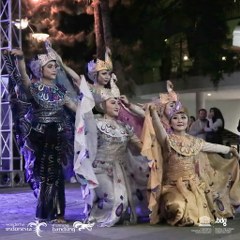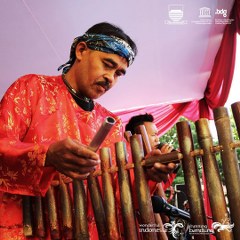Peacock Dance
This peacock dance was created in the 1950s by an artist and dance choreographer from West Java named Raden Tjetje Soemantri. He took the beautiful movements of the peacock which was then made into a dance. Initially, the creation of this dance was intended to entertain the delegates of the Asian-African Conference at a reception in Bandung in 1955.
This dance is a type of New Creation dance that expresses the life of the peacock, the procedures and movements of the peacock's life are brought to the stage. The characteristics of the peacock dance can be seen from the clothes used by the dancers, namely clothes whose motifs depict the shape and color of peacock feathers, plus a pair of wings which also have peacock wings or tail attached to the back of the dancer.
The tips of the wings are attached to the fingers of the dancers so that if both hands are stretched out, they will form a peacock that is spreading its wings. The picture of the peacock will be even clearer with a crown (badong) that is attached to the head of each dancer.
This dance is usually danced in a rampak manner, three or more dancers each playing a female peacock or a male peacock. The accompaniment of the gending song is the song Macan Ucul. Among the dances created by R. Tjetje Somantri, perhaps this peacock dance is the most famous in Indonesia and abroad, people from Bandung!
Source: Variety of Copyright by Atik Soepandi, S.Kar - Drs. Enip Sukanda P - Drs. Ubun Kubarsah
Sunda Peacock Dance, Intangible Cultural Heritage of Bandung City
Indonesia is a country with a very rich cultural diversity. There are so many diverse cultures in Indonesia and one of them is the art of dance which has become a noble heritage that must be preserved. Each region in Indonesia has a unique dance art. One of them is the peacock dance, a dance art originating from the Bandung area, West Java.
This peacock dance was created in the 1950s by an artist and dance choreographer from West Java named Raden Tjetje Soemantri. He took the beautiful movements of the peacock which was then made into a dance. Initially, the creation of this dance was intended to entertain the delegates of the Asian-African Conference at a reception in Bandung in 1955.
Since its creation, Tjetje's Sunda Peacock Dance has only been performed five times, namely in a series of KAA activities in the backyard of Pakuan Building in 1955; in 1955 at the Orient Hotel, Bandung; in 1957 in order to welcome the presence of Voroshilof, President of the USSR (Russia) at the Pakuan Building; at the Hotel Savoy Homann in 1958 and in a dance performance at the YPK in 1958.
After the death of Raden Tjetje Somantri in 1963, Irawati Durban as his student perfected the arrangement of the Peacock Dance created by Rd. Tjetje Somantri by reworking the structure of the dance choreography.
Along with the times, Peacock Dance began to be widely known. The peacock dance is a modern or contemporary dance, where every movement in this dance is created freely with their own creations. This dance is not a traditional dance or classical dance.
This dance is inspired by peacocks and adapted from the movements of a male peacock with the charm of its beautiful tail feathers when it attracts a female peacock and has beautiful feathers, like the costumes worn by the dancers. Usually this dance is used as entertainment or welcome to guests at large events.
Because of the beauty of its movements, this dance is able to become the pride of the people of West Java and Indonesia at large. The movement of the Peacock Dance has a meaning as one of the manifestations of admiration for the beauty of peacocks in the wild. It is clear that this dance is taken from the behavior of the male peacock when he wants to attract the female peacock.
One of the beautiful movements shown is the movement of the male peacock showing the beauty of its tail feathers. Each dancer has their respective roles, namely as male peacocks and female peacocks.
This Peacock Dance is usually danced by women wearing very glamorous, aesthetic, exotic clothes, as well as kinesthetic compositions. This makes the Sunda Peacock Dance has its own allure for anyone who dances and watches it. Every movement of the dancers is accompanied by traditional music called gending macan ucul.
Amazingly, the Kota Sunda Peacock Dance in 2020 was awarded as one of the Intangible Cultural Heritage of Indonesia. In addition to being an icon for the city of Bandung, the Sunda Peacock Dance is also one of the cultural icons of West Java which is well known to foreign countries.





